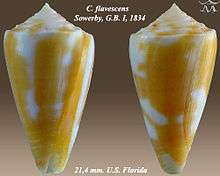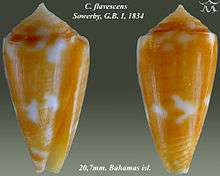Conus flavescens
Conus flavescens, common name the flame cone, is a species of sea snail, a marine gastropod mollusk in the family Conidae, the cone snails and their allies.[1]
| Conus flavescens | |
|---|---|
 | |
| Apertural and abapertural views of shell of Conus flavescens Sowerby, G.B. I, 1834 | |
| Scientific classification | |
| Kingdom: | Animalia |
| Phylum: | Mollusca |
| Class: | Gastropoda |
| Clade: | Caenogastropoda |
| Clade: | Hypsogastropoda |
| Clade: | Neogastropoda |
| Superfamily: | Conoidea |
| Family: | Conidae |
| Genus: | Conus |
| Species: | C. flavescens |
| Binomial name | |
| Conus flavescens G. B. Sowerby I, 1834 | |
| Synonyms | |
| |

There is one subspecies: Conus flavescens caribbaeus Clench, 1942 (synonyms: Conus caribbaeus Clench, 1942, Gradiconus flavescens caribbaeus (Clench, 1942), Tuckericonus caribbaeus (Clench, 1942), Tuckericonus flavescens caribbaeus (Clench, 1942))
Like all species within the genus Conus, these snails are predatory and venomous. They are capable of "stinging" humans, therefore live ones should be handled carefully or not at all.
Distribution
This marne species occurs in the Caribbean Sea and the Gulf of Mexico off Florida, USA, the Greater Antilles and off the Bahamas.
Description
The maximum recorded shell length is 25 mm.[2] The smooth shell is grooved towards the base. Its color is yellowish, variegated with large irregular white blotches, arranged mostly just below the shoulder angle, and below the middle of the body whorl, so as to form two interrupted bands.[3]
Habitat
Minimum recorded depth is 0 m.[2] Maximum recorded depth is 122 m.[2]
References
- Bouchet, P. (2015). Conus flavescens G. B. Sowerby I, 1834. Accessed through: World Register of Marine Species at http://www.marinespecies.org/aphia.php?p=taxdetails&id=420210 on 2015-04-29
- Welch J. J. (2010). "The "Island Rule" and Deep-Sea Gastropods: Re-Examining the Evidence". PLoS ONE 5(1): e8776. doi:10.1371/journal.pone.0008776.
- G.W. Tryon (1884) Manual of conchology, structural and systematic, with illustrations of the species, vol. VI; Philadelphia, Academy of Natural Sciences
- David K. Camp, William G. Lyons, and Thomas H. Perkins: Checklists of Selected Shallow-Water Marine Invertebrates of Florida; Florida Marine Research Institute, FMRI Technical Report TR-3, ISSN 1092-194X
- Petit, R. E. (2009). George Brettingham Sowerby, I, II & III: their conchological publications and molluscan taxa. Zootaxa. 2189: 1–218
- Puillandre N., Duda T.F., Meyer C., Olivera B.M. & Bouchet P. (2015). One, four or 100 genera? A new classification of the cone snails. Journal of Molluscan Studies. 81: 1–23
External links
- The Conus Biodiversity website
- Cone Shells – Knights of the Sea
- "Gradiconus flavescens". Gastropods.com. Retrieved 16 January 2019.
| Wikimedia Commons has media related to Conus flavescens. |
Gallery
Below are several color forms:
 Conus flavescens Sowerby, G.B. I, 1834
Conus flavescens Sowerby, G.B. I, 1834 Conus flavescens Sowerby, G.B. I, 1834
Conus flavescens Sowerby, G.B. I, 1834 Conus flavescens Sowerby, G.B. I, 1834
Conus flavescens Sowerby, G.B. I, 1834 Conus flavescens Sowerby, G.B. I, 1834
Conus flavescens Sowerby, G.B. I, 1834 Conus flavescens Sowerby, G.B. I, 1834
Conus flavescens Sowerby, G.B. I, 1834 Conus flavescens Sowerby, G.B. I, 1834
Conus flavescens Sowerby, G.B. I, 1834 Conus flavescens Sowerby, G.B. I, 1834
Conus flavescens Sowerby, G.B. I, 1834 Conus flavescens Sowerby, G.B. I, 1834
Conus flavescens Sowerby, G.B. I, 1834